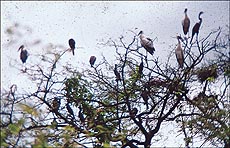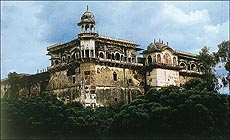A
kingdom of the jats
There
is much more to Bharatpur than birds,
says M.P Nathanael
LOOKS a very insignificant town at
first sight. But spend a day or two and, hey presto,
Bharatpur with its fortress, palaces, religious places
and the world-famous bird sanctuary stands transformed
into a beautiful township that attracts tourists, largely
foreigners, in hordes. Replete with acts of chivalry and
valour, the history of this township is at once
interesting and awe-inspiring.
 About 175 km from Delhi on the
Delhi-Mumbai trunk route, Bharatpur had been ruled by Jat
rulers, the first being Badan Singh. A revolt against the
Mughal emperor Aurangzeb by some petty Jat chieftains led
to open warfare and frequent skirmishes. With the death
of Aurangzeb in the early eighteenth century, Badan
Singh, a Jat chieftain, carved out a kingdom of Bharatpur
in 1722 and became its ruler. Suraj Mal, About 175 km from Delhi on the
Delhi-Mumbai trunk route, Bharatpur had been ruled by Jat
rulers, the first being Badan Singh. A revolt against the
Mughal emperor Aurangzeb by some petty Jat chieftains led
to open warfare and frequent skirmishes. With the death
of Aurangzeb in the early eighteenth century, Badan
Singh, a Jat chieftain, carved out a kingdom of Bharatpur
in 1722 and became its ruler. Suraj Mal,
his son by a favourite
concubine, succeeded him and fortified it with walls of
packed mud and a moat full of water surrounding it.
Known as ‘Loha
Garh’ or Iron Fort, the inaccessible fort could
withstand repeated attacks of British forces led by Lord
Lake in 1805 when they laid siege for over six weeks.
Having lost over 3000 soldiers, the British forces had to
retreat and strike a compromise with the Bharatpur ruler.
Of the two gates in the fort, one in the north is known
as Ashtdhaatu (eight metalled) gate while the one facing
the south is called Chowburja (four-pillared) gate.
 Within
the precincts of the fort are three palaces — one of
which, Kothi Khas, now serves as a museum while the other
two, Kishori Mahal and Mahal Khas, are sadly in a
dilapidated state. Within
the precincts of the fort are three palaces — one of
which, Kothi Khas, now serves as a museum while the other
two, Kishori Mahal and Mahal Khas, are sadly in a
dilapidated state.
Archaeological finds
— intricately carved sculptures and ancient
inscriptions dating back to the second century — are
on display in the museum, the entrance to which is free
on Mondays.
Brightly designed baths
or hamams with walls and domes are some of the
attractions in the palace museum.
Jawahar Burj and Fateh
Burj, two of the eight magnificent towers within the
precincts of the fort, call for special mention. While
the former was built by Maharaja Suraj Mal to commemorate
his victory over the Mughals, the latter was built by him
to signify his victory over the British.
The Jawahar Burj has a
special significance for Jat rulers as the coronation
ceremony was always held at this spot.
 The Ganga Mata Temple, the laxman Temple
and the mosque are the other places of interest in the
city. The Ganga Mata Temple, the laxman Temple
and the mosque are the other places of interest in the
city.
A visit to Bharatpur
would undoubtedly be incomplete without a visit to the
world famous Keoldeo National Park, also known as Ghana
Bird Sanctuary.
Hailing one of the 90
odd rickshaws that take the visitors around in the
sanctuary, with the rickshaw-pullers doubling as guides,
one can have a view of rare birds in this sanctuary.
Known as Keoldeo because of the Keoldeo temple of Lord
Shiva in the vicinity, this 29 sq km area was converted
into a sanctuary by Prince Bhamji of Morvi state who had
been appointed as Regent of Bharatpur towards the end of
nineteenth century.
Originally intended for
duck shooting and not bird watching by Maharaja Kishan
Singh, an area of 11 sq km was got filled with water from
the Ajan Bundh reservoir and then drained out, leaving
the low land filled with water. Bushes of babool and
other thorny trees were got planted to attract varieties
of birds.
The first shoot was
organised by the rulers of Bharatpur in 1902 in honour of
Lord Curzon. Lord Linlithgow, Viceroy and
Governor-General of India, established a record of
shooting 4273 ducks in 1938. Among the royal guests of
the Bharatpur ruler were visitors from Afghanistan, Iran,
Malaysia and few other countries who entertained
themselves with the royal game of duck shooting at the
sanctuary.
The place, having been
declared a bird sanctuary in 1964 largely due to the
efforts of the well-known ornithologist, the late Dr
Salim Ali, was closed for duck shooting from that year.
As many as 400 species
of birds are known to have been spotted in this
sanctuary. Migratory birds from Central Asia, Tibet and
Afghanistan and Siberian cranes from the Arctic, and
barheaded geese from China have been visiting this park
annually to spend winters and breed here.
Colonies of egrets,
herons, pelicans, ebis, storks, spoon bills and
cormorants can be spotted all over the park. "One
needs to be a keen bird watcher and even a little
knowledgeable about birds, if one has to really enjoy
bird watching here", says our rickshaw
puller-cum-guide Rajinder. "Even animals like
spotted deer, hyenas, porcupines can be spotted
here", he adds.
A large number of
rickshaw-pullers in this town are Sindhi sikhs and they
are never known to overcharge. Explains one of them:
"We are here since Independence as our parents
migrated from Pakistan. We are over a few thousands in
this city involved in various professions with most of us
being rickshaw-pullers."
It is indeed a delight
to go around the town in these rickshaws watching people
and places while being briefed by these ever-cheerful
rickshaw-pullers.
|

